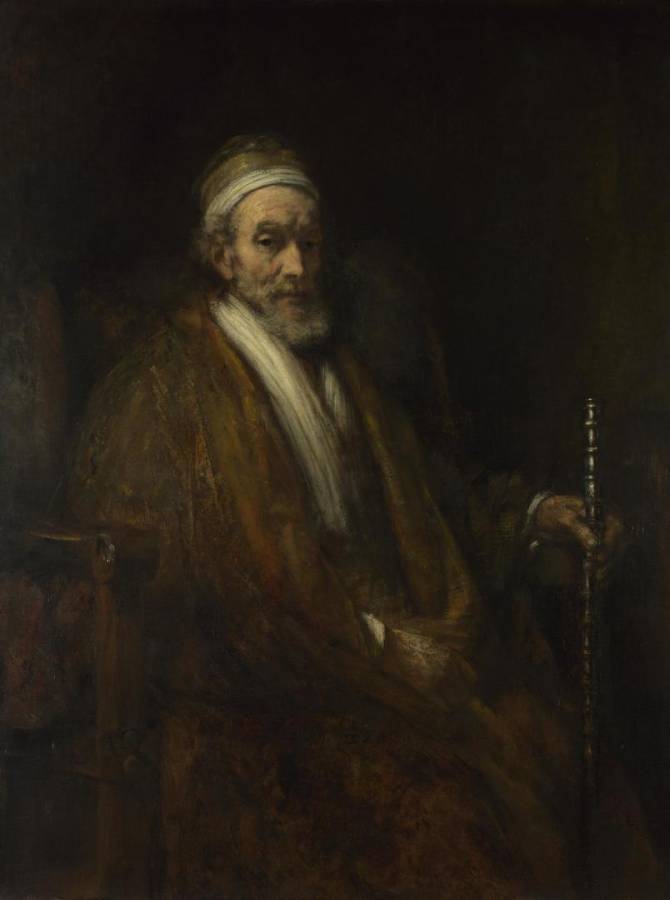Rembrandt (1606-1669)
Portrait of Jacob Trip
c.1661
Oil on canvas, 130.5 x 97 cm
National Gallery, London
This wise-looking old man is Jacob Trip. He was one of the biggest arms dealers during one of the most turbulent periods of conflict in European history. However, Rembrandt has given him the air not of a warmonger, but of a priest or religious figure – a bringer, perhaps, of peace and thus of prosperity. By 1660, Amsterdam was one of the richest cities in Europe, its citizens profiting from a network of worldwide trade – but that network had to be protected aggressively by a powerful navy.
As Amsterdam flourished, it expanded rapidly, with smart merchants’ houses rising along the canals which ringed the city. In 1660, work started on the largest and most distinctive of these new buildings – the Trippenhuis, a palatial residence built for Jacob Trip’s two sons. It survives to this day, and that the Trips were proud of their trade is clear: the chimneys are shaped like cannons, while palm fronds, representing peace, are carved on the facade.
Jacob, now about 85, had built the fortune which made his family one of the wealthiest in the Netherlands. His portrait was almost certainly commissioned – along with a portrait of his wife Margaretha – to hang in the Trippenhuis. The sheer size of the canvases tells us that they were intended to be shown in an impressively large room – and both were once larger still, but have been trimmed by a few centimetres around their edges. Now in his mid-fifties, Rembrandt was perhaps no longer the most fashionable portrait painter, but it is testimony to his fame that the Trip family nevertheless turned to him to paint the portraits of this powerful couple.
Trip is dressed informally. These are indoor clothes: a shawl instead of a collar, a loose robe, a nightcap. They also hint at his wealth – the robe is probably padded silk of a type imported from Japan. But the style is also reminiscent of a tabbaard, a robe traditionally worn by scholars and clerics. It is this, combined with Trip’s upright poise and his staff, that gives him the air of a priest or a figure from the Old Testament. Some have argued that the stick, which Rembrandt has been careful to emphasise with white highlights, is indicative of Trip’s frailty. But this one – with no handle to lean on – would have made a poor support, and Trip holds it lightly between his thumb and forefingers. We could see it as an instrument of power – a sceptre rather than a prop.
Either way, it is clear that Trip is to be venerated as rich, wise and powerful. The question is why Rembrandt painted husband and wife in two distinct styles. The portrait of Jacob has been executed at some speed and with unusual economy. Rembrandt, usually meticulous in his application of paint when depicting flesh tones, has been very sparing here, especially around the eyes, the shadowed side of Trip’s face and on his hands. Compare this to the much more intensely layered paintwork of Margaretha’s skin. Trip’s scarf is rendered with just a few long, white brushstrokes and much of the lower part of his robe is scarcely painted at all, with only a few suggestive touches applied on top of the background colour.
There have been several attempts to explain these differences. We know that Trip died in 1661, around the same time the portrait was commissioned. Perhaps Rembrandt was working unusually fast to capture the likeness of a man who was mortally ill. Perhaps he started painting only after Trip’s death and had to rely on other portraits. Or perhaps he was deliberately contrasting the fading presence of a dying man with the vibrant energy of his wife, who still had another ten years to live.
This is one of a pair of portraits of a husband and wife, one of the richest couples in the Netherlands. Jacob Trip, who made much of his money as an arms dealer, had been married to Margaretha de Geer for nearly 60 years. The paintings, both in the National Gallery, were made to hang together, almost certainly in one of the grand reception rooms of a palatial new residence – the Trippenhuis – which was being built in Amsterdam for their sons.
Rembrandt creates a fascinating contrast between the couple. Their poses are asymmetrical – Margaretha meets our gaze head on, Jacob sits askew, his mind apparently elsewhere – and he uses different painting techniques. Jacob is rendered using swift, confident brushstrokes, while Margaretha’s skin and ruff are worked with great intensity and attention to detail. (NG)
Companion:
 Rembrandt (1606-1669)
Rembrandt (1606-1669)
Margaretha de Geer
c.1661
National Gallery, London
In seventeenth-century Holland, it was common for married couples to be depicted separately in paintings designed to be hung as a pair, with the woman’s portrait invariably hung to the right. This placed the wife to her husband’s left – or, as it was regarded at the time, his inferior side: marriage was a partnership steered by the man.
These portraits are particularly large examples, reflecting the status of the couple, Jacob Trip and Margaretha de Geer – who belonged to one of the richest families in Holland. They were probably commissioned by two of the Trips‘ sons, to be hung in a palatial residence which they were building in Amsterdam.
The poses are unusual. Normally we’d expect each sitter to be half turned towards the other. But Margaretha faces the viewer directly. She may be sitting on her husband’s inferior side, but Rembrandt seems to imply that she is the more active and engaged of the two. (NG)
See also:
• Trip, Jacob (c.1576-1661)
